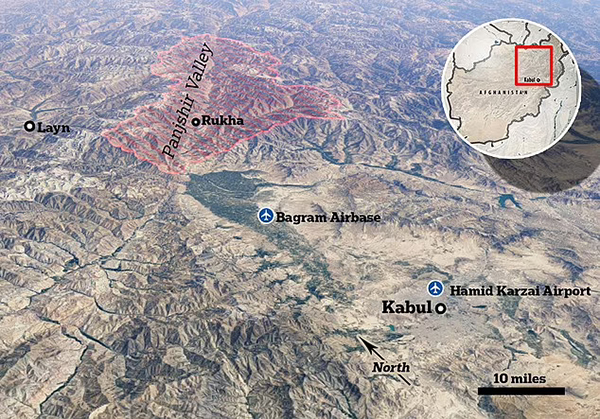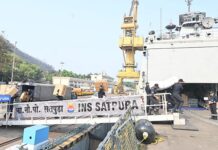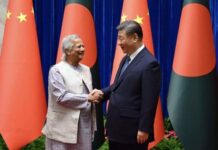Following the Fall of Kabul, anti-Taliban forces, including former Vice President Saleh, moved into the Panjshir Valley, the only area of Afghanistan not controlled by the Taliban, in order to create a new resistance front. Created after the 2021 Taliban offensive, under the leadership of Afghan politician and military leader Ahmad Massoud, the National Resistance Front of Afghanistan (NRF), also known as the Second Resistance, vowed to fight the Taliban.
The group exercised de facto control over the Panjshir Valley, which is largely contiguous with Panjshir Province and, in end-August 2021, was “the only region out of the Taliban’s hands”. The alliance constituted the only organized resistance to the Taliban in the country. The resistance called for an “inclusive government” of Afghanistan; one of their objectives was speculated to be a stake in the new Afghan government.
The Panjshir Valley, a mountainous region, was a formidable base of operations for anti-Soviet fighters and later for the original Northern Alliance. It was the birthplace of anti-Soviet and Northern Alliance leader Ahmad Shah Massoud. Ahmad Shah Massoud’s son, Ahmad Massoud, was widely seen as his successor.
On 17 August 2021, First Vice President Amrullah Saleh—citing provisions of the Constitution of Afghanistan—declared himself President of Afghanistan from the NRF’s base of operations in the Panjshir Valley, and said that he would continue military operations against the Taliban from there. His claim to the presidency was endorsed by Massoud and former Afghan Minister of Defence Bismillah Mohammadi along with the Afghan embassy in Tajikistan and its ambassador Mohammad Zahir Aghbar.
By 17 August, the Panjshir Valley was “under siege on all sides.” Ahmad Massoud wrote in an op-ed to The Washington Post on 18 August 2021, calling for the rest of the world to help them, as he admits that ammunition and supplies would run out unless Panjshir could be supplied.
On 17 August 2021, ethnic Tajik former soldiers of the Afghan National Army began to arrive in the Panjshir valley, with tanks and personnel carriers in support of the resistance. They regrouped in Andarab district, Baghlan after they escaped Kunduz, Badakhshan, Takhar, and Baghlan before moving to the safety of Panjshir.
Saleh’s command managed to recapture Charikar, the provincial capital of Parwan Province, which had been held by the Taliban since 15 August At around the same time, unconfirmed reports stated that remnants of the Afghan Army had began massing in the Panjshir Valley at the urging of Massoud, along with the Minister of Defense Bismillah Mohammadi and provincial commanders. Local civilians also responded to his calls to be mobilized.
The Panjshir resistance also claimed to have the support of Abdul Rashid Dostum and Atta Muhammad Nur on 18 August 2021, while it was reported that members of Dostum’s group, which had retreated into Uzbekistan, said that 10,000 of their soldiers could join forces with the Panjshir resistance, creating a combined force of 15,000 or more.
On 20 August, a group of anti-Taliban forces was organised in Baghlan Province, headed by Abdul Hamid Dadgar. The group took over the Andarab, Pul-e-Hesar and De Salah districts of Baghlan Province. Former Baghlan prison commander Abdul Rahman stated that “All people of the valley have risen up against the Taliban.”
On 6 September, the Taliban claimed victory in controlling the province. The NRF, however, denied the Taliban victory, stating that they are still “all over the valley”.
On September 9, the NRF announced that a parallel government would be created in response to the Taliban’s formation of its government in Kabul.It was announced on September 29 that Amrullah Saleh would lead the government in exile, according to a statement published by the Afghan Embassy in Geneva, Switzerland, which also backed the NRF.
On November 1, it was reported that the NRF had opened a liaison office in Washington DC after being registered with the US Justice Department in order to carry out lobbying missions to various politicians working in the city.
Tajikistan’s Concern
Whereas neighbouring Uzbekistan, Russia and China were keen to establish decent diplomatic relations with the Taliban, Tajikistan remained a fierce critic of Afghanistan’s new rulers.
After Kabul fell on August 15 amid the precipitous US withdrawal, Tajik President Emomali Rahmon warned that Taliban-controlled Afghanistan threatened to act as a breeding ground for terrorism once again.
Rahmon is keen to present himself as a defender of Afghanistan’s ethnic Tajiks, the second largest ethnic group in Afghanistan, many of whom are opposed to the Taliban.
Why the Resistance Failed
Ultimately the resistance in Panjshir failed and they retreated to Tajikistan. Taliban forces conquered the strategically important region amidst reports that the leader of the resistance fighters Ahmad Massoud has left for a secure place outside Afghanistan.
The US and its allies abandoned the Northern Alliance completely.
Taliban’s international support strengthened the Islamist militants. The Taliban had the unstinting support from the Chinese, fairly unstinting support from the Russians and unstinting support from the Pakistanis including pilots. They also had in their possession all the war matériel that the Americans could not destroy, and that was substantial. They also have Chinese drones and they had assistance in operating them from the ISI.
Pakistan helped the Taliban with arms, ammunition and, reports suggest, even fighter jets to outmanoeuvre the opposition.
The Taliban was a lot better armed, much more capable, more lethal, and with they better international ties than the Taliban before 9/11, and in contrast the Panjshiris had less support.
There was also a concern with Saleh and Massoud coming from different political backgrounds, with the latter not having the same level of charisma as his father, even though both oppose the Taliban. Ahmad was clearly not yet in the league of his father, among the greatest guerrilla fighters of the last century.
The resistance had a better chance of gaining more support from Afghans of other ethnic groups resisting the Taliban if Saleh were seen as the head of a broad coalition rather than only representing Tajiks.
To the extent that the fall of Panjshir marks the success of the Taliban and the Pakistan military, it is a setback for India as well. New Delhi, which had earlier backed the Northern Alliance through funds and material, appears to have taken a cue from the Americans and stepped back this time.


















